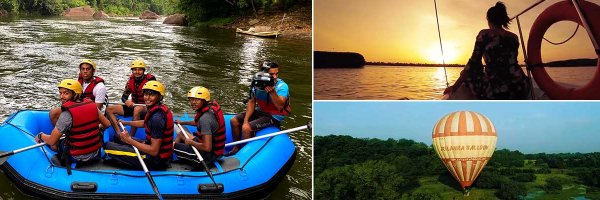
Gal Oya national park, Boat safari
- Gal Oya national park is famous due to its' boat safari in Senanayaka Samudra reservoir. It is located 314 km away from Colombo and about 1 and half hours' drive to the north of Arugam Bay.
"Makara", the natural tunnel, the water stream falls through that feed the Senanayaka Samudra is an amazing place to explore.
Gal Oya national park offers you a rare opportunity of getting closer to exotic animals and birds. The "sitting-and-swimming" elephants in the serene water of the Senanayaka Samudra always make a picturesque scene that can not be seen anywhere in the world.
- Gal Oya national park is famous due to its' boat safari in Senanayaka Samudra reservoir. It is located 314 km away from Colombo and about 1 and half hours' drive to the north of Arugam Bay.
"Makara", the natural tunnel, the water stream falls through that feed the Senanayaka Samudra is an amazing place to explore.
Gal Oya national park offers you a rare opportunity of getting closer to exotic animals and birds. The "sitting-and-swimming" elephants in the serene water of the Senanayaka Samudra always make a picturesque scene that can not be seen anywhere in the world.
Most Striking Feature
- Gal Oya national park offers you a rare opportunity of getting closer to exotic animals and birds. You can get out of your safari vehicle and explore the jungle on foot; something that adds to the excitement.
The reservoir within the park allows you to experience an intimate boat expedition; the only park where you can enjoy a safari by boat as well as by jeep.
Gal Oya park is famous around the world for ‘sitting-and-swimming’ elephants. The serene water of the Senanayake Samudraya reservoir is punctuated with a variety of islands. So, the elephants swimming from one island to the other, always make a picturesque scene.
Landscape & Views
- About 45% of the Gal Oya national park is covered with the dry-zone forest. 33% contains an area of Savannah-like grasslands and 9% is mountainous grasslands. 10% consists of water bodies and 2% is covered with Chena, an area of virgin or secondary timberland.
The terrain of the Gal Oya, situated between the dry-zone forest and the Savannah, makes it one of the best sites for wildlife photography. The water stream which feeds the Senanayake Samudraya falls to the reservoir through a natural tunnel. That place is known as ‘Makara’ or ‘Makara Kata,’ meaning Dragon’s Mouth in the Sinhala language.
The mountains of Nilgala, Ulpotha, and Danigala with an elevation of 30 m to 900 m are situated in the national park.
History & Archaeology
- Gal Oya is home for one of the Veddah clans, the indigenous hunter-dwellers who are still alive in Sri Lanka. In the Nilgala area alone, there are about 80 Veddah families living. The Henebedde Cave which you can find at the Danigala area --the home of the Henebadde Veddahs-- contains historic Brahmi inscriptions, something priceless for any history lover.
Biodiversity & Rare Species
- Gal Oya national park is home to over 32 species of mammals, including the old-world monkeys –Langur and Toque Macaque which is endemic to Sri Lanka, the leopard, sloth bear, wild boar, water buffalo, and the deer.
The park is blessed with a dazzling array of colourful bird species which makes it a must-see destination for birdwatchers. The island named ‘Bird’s Island,’ found within the reservoir, is a rare nesting place for birds.
Access
The entrance to the Gal Oya National Park is at Inginiyagala which can be reached from Colombo:
From Ratnapura – Pelmadulla – Udawalawe – Thanamalwila – Wellawaya - Moneragala - Siyambalanduwa - Inginiyagala.
Visiting hours for the Park - 6 a.m. to 6 p.m.
Mode of safaris - Jeep Safaris & Boat Safaris
Best time of the day to visit the Park - 6 a.m. to 10 a.m. & 3 p.m. to 6 p.m.
Best months to visit - Throughout the year. The sighting of the swimming elephant is from March to July.

 +39 - 39 - 307 6 3730
+39 - 39 - 307 6 3730 +94 - 74 - 000 9208
+94 - 74 - 000 9208










Share this page